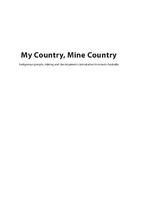My Country, Mine Country: Indigenous people, mining and development contestation in remote Australia (CAEPR Monograph 33)
| dc.contributor.author | Scambary, Benedict | |
| dc.date.accessioned | 2013-11-20 00:00:00 | |
| dc.date.accessioned | 2020-04-01T14:50:14Z | |
| dc.date.available | 2020-04-01T14:50:14Z | |
| dc.date.issued | 2013 | |
| dc.identifier | 459939 | |
| dc.identifier | OCN: 1030815465 | en_US |
| dc.identifier.uri | http://library.oapen.org/handle/20.500.12657/33543 | |
| dc.description.abstract | Agreements between the mining industry and Indigenous people are not creating sustainable economic futures for Indigenous people, and this demands consideration of alternate forms of economic engagement in order to realise such ‘futures’. Within the context of three mining agreements in north Australia this study considers Indigenous livelihood aspirations and their intersection with sustainable development agendas. The three agreements are the Yandi Land Use Agreement in the Central Pilbara in Western Australia, the Ranger Uranium Mine Agreement in the Kakadu region of the Northern Territory, and the Gulf Communities Agreement in relation to the Century zinc mine in the southern Gulf of Carpentaria in Queensland. Recent shifts in Indigenous policy in Australia seek to de-emphasise the cultural behaviour or imperatives of Indigenous people in undertaking economic action, in favour of a mainstream conventional approach to economic development. Concepts of ‘value’, ‘identity’, and ‘community’ are key elements in the tension between culture and economics that exists in the Indigenous policy environment. Whilst significant diversity exists within the Indigenous polity, Indigenous aspirations for the future typically emphasise a desire for alternate forms of economic engagement that combine elements of the mainstream economy with the maintenance and enhancement of Indigenous institutions and ‘livelihood’ activities. Such aspirations reflect ongoing and dynamic responses to modernity, and typically concern the interrelated issues of access to and management of ‘country’, the maintenance of Indigenous institutions associated with family and kin, access to resources such as cash and vehicles, the establishment of robust representative organisations, and are integrally linked to the derivation of both symbolic and economic value of livelihood pursuits. | |
| dc.language | English | |
| dc.relation.ispartofseries | CAEPR Monograph | |
| dc.subject.classification | thema EDItEUR::J Society and Social Sciences::JB Society and culture: general::JBS Social groups, communities and identities::JBSL Ethnic studies::JBSL1 Ethnic groups and multicultural studies::JBSL11 Indigenous peoples | en_US |
| dc.subject.classification | thema EDItEUR::5 Interest qualifiers::5P Relating to specific groups and cultures or social and cultural interests::5PB Relating to peoples: ethnic groups, indigenous peoples, cultures and other groupings of people::5PBA Relating to Indigenous peoples | en_US |
| dc.subject.classification | thema EDItEUR::L Law::LN Laws of specific jurisdictions and specific areas of law::LNC Company, commercial and competition law: general::LNCR Energy and natural resources law | en_US |
| dc.subject.other | indigenous studies | |
| dc.subject.other | mining | |
| dc.subject.other | Northern Territory | |
| dc.subject.other | Pilbara | |
| dc.subject.other | Waanyi | |
| dc.title | My Country, Mine Country: Indigenous people, mining and development contestation in remote Australia (CAEPR Monograph 33) | |
| dc.type | book | |
| oapen.identifier.doi | 10.26530/OAPEN_459939 | |
| oapen.relation.isPublishedBy | ddc8cc3f-dd57-40ef-b8d5-06f839686b71 | |
| oapen.series.number | 33 | |
| oapen.place.publication | Canberra | |
| oapen.remark.public | Relevant Wikipedia pages: Indigenous Australians - https://en.wikipedia.org/wiki/Indigenous_Australians; Indigenous peoples - https://en.wikipedia.org/wiki/Indigenous_peoples; Northern Territory - https://en.wikipedia.org/wiki/Northern_Territory; Pilbara - https://en.wikipedia.org/wiki/Pilbara; Waanyi - https://en.wikipedia.org/wiki/Waanyi | |
| oapen.identifier.ocn | 1030815465 |

